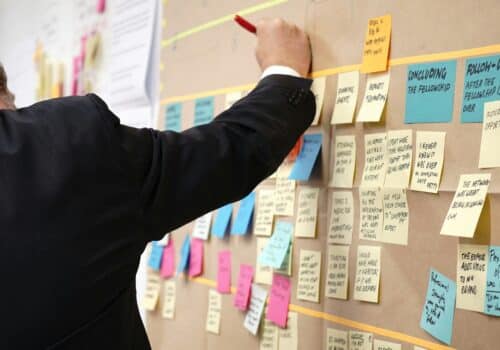Want Your Employees to Use Critical Thinking Skills? Answer These Questions First
This is our last of four posts on critical thinking. Let’s pick up where we left off . . .
Examining the five articles we reviewed in our last post reveals that three things are required to nurture critical thinking in the workplace: skill, time, and trust. As we stated previously, these three components are necessary for critical thinking in the same way that all three legs of a three-legged stool are necessary to the stool. One or two legs are nice to have, but you can’t sit on the stool until you have all three legs. Similarly, one or two components of critical thinking are nice to have in your business, but you can’t rely on critical thinking to solve real problems or grow your business until you have all three components in place.
Critical thinking is a skill
Critical thinking is a skill in much the same way that several of your business activities are: sales, ordering, invoicing, stocking, payroll, and the like. As such, it is a skill that can be taught, coached, encouraged, learned, and improved over time. Unlike other business activities, critical thinking happens in all departments across an organization.
The questions for business leaders then become:
- Do I use critical thinking skills at work?
- If so, do I have the know-how and personality to model and teach these skills?
- If not, does someone in my organization have the ability and the time to teach these skills or should I hire an outside coach or consultant?
Critical thinking takes time
Environment matters with critical thinking. It is much harder to think critically if someone is constantly under pressure to perform. Top-down, high-pressure work environments are not conducive to critical thinking. If you expect your employees to follow directives without question and to constantly be in production-mode, but then expect them to engage in critical thinking, you’re asking for two mutually exclusive things.
Why? Because much of the creativity that critical thinking requires can only occur in a more relaxed state of mind. You’ll often hear people say that they have their best ideas in the shower or as they are falling asleep. This is because they are allowing their mind to wander, to dream, to contemplate—and play with—possible solutions while holding onto the problem loosely. Scientists call this kind of thinking diffuse thinking, and outside-the-box solutions usually emerge from this kind of thinking.
Focused thinking is the scientific term for the opposite of diffuse thinking. Focused thinking is concentrating on a problem and looking for the simplest solution in a systematic, if not regimented, way. Solving a difficult math problem, following complicated directions, and navigating through an unfamiliar location often requires this kind of concentration and focused thinking. Tasks that are repetitive or complex require this kind of thinking.
The more hectic the work environment, the less employees are going to engage in diffuse thinking because hectic environments require employees to constantly be focused and moving to the next thing. There is no time to engage in diffuse thinking in such a workplace.
Furthermore, chaotic or hostile workplaces are toxic to diffuse thinking and can even degrade an employees’ ability to engage in focused thinking. When a workplace is disorganized or unsafe to work in, employees tend to spend more time being vigilant and looking out for their own needs rather than thinking about the needs of the business.
Critical thinking, then, requires a mix of the two. Both diffuse and focused thinking have roles to play. Diffuse thinking will often dream up several creative potential solutions to a problem and then focused thinking comes into play when it comes time to evaluate and implement those ideas in the real world.
Again, business leaders and managers need to start with some questions about the work environment in their organization and what employees are being asked to do:
- What is most important to me? How the work gets done or that the work gets done?
- If I was in my employees’ shoes, would I enjoy working for me? Why or why not?
- If I was being asked to do what my employees were doing, would I be stressed out all the time, or would I have time to be creative?
It is often very difficult for business leaders and managers to answer these questions objectively. Sometimes leaders have been in leadership positions for so long that they forget what it’s like to be the employee doing the work, in the trenches as it were. Or leaders remember all-to-well what it was like to do the work because they did it themselves for a number of years, which can breed an attitude of, I put my time in, now it’s your turn.
Whatever the case, if business leaders and managers have a difficult time answering these questions objectively, the outside observations of a coach or consultant can be instrumental in determining whether or not your business is a place that nurtures critical thinking.
Critical thinking requires trust
One more principle emerges from the articles we looked at about critical thinking. Critical thinking is collaborative thinking, and as a result, it requires trust among employees and between employees and their leaders. We alluded to this in the section above when we mentioned how detrimental chaotic or hostile workplaces are to critical thinking. To see how environment and trust are distinct, let’s engage in a quick thought experiment:
Imagine a workplace that is organized and asks employees to engage in times of intense concentration, the focused thinking we described above. This same workplace also allows employees the time to occasionally engage in activities that look like time wasters from the outside. The much-maligned foosball table in the modern workplace is one example. Outdoor meetings, walking meetings, or offsite meetings at a coffee shop might be other examples of so-called time wasters. Semi-structured work sessions, creating mood boards, or splitting people into cross-departmental work dyads, all are examples of activities that can create and nurture an environment where creative thinking flourishes and grows.
Now, imagine that some very creative solutions start to emerge from these activities, solutions to some of your business’s most nagging problems. Many of these creative solutions are weird and impractical, but some might actually be doable. And one or two are not only doable, but they’re also exceedingly effective and efficient ways to solve your problems and grow your business.
Lastly, imagine what would happen if, as a business leader, you routinely shot these ideas down as they came across your desk. Perhaps you occasionally knew something about the circumstances of your business that ultimately made your employees’ solutions impractical to implement. Or maybe you just didn’t like the solutions that your employees came up with. Whatever the reason, pretend that every time your employees engaged in critical thinking, you ignored their ideas and put your own ideas in place instead. What would happen over time?
Does this scenario sound farfetched? I can assure you there are many fantastic places to work, places that put a premium on teaching and coaching critical thinking, that create the environment and provide the time that employees need to engage in critical thinking, but that fail to trust the critical thinking process because the leadership team intervenes and implements the solutions that it wants to implement. This undercuts the value of critical thinking and ultimately erodes an employee’s desire to take critical thinking seriously. If leadership is simply going to do what it wants, the employee thinks, what’s the point of all of these critical thinking activities? Employees start to think of critical thinking activities as feel-good time wasters that don’t actually affect change in the workplace.
There is no doubt that the topic of creative thinking has become “a thing” in business over the last five-to-ten years. As such, businesses can engage in the activities associated with fostering creative thinking for a lot of different reasons—reasons that have nothing to do with the fact that critical thinking skills play an important role in solving real business problems, affecting real change, and helping grow a business in real ways. For the sake of appearing modern or for wanting to be attractive to potential employees, businesses can “do all the right things” regarding critical thinking in the workplace. In so doing, they have two of the legs in their critical thinking stool, but not all three. They teach the skills, they create the necessary environment, but they don’t actually trust critical thinking to do anything for their businesses—they can’t actually sit on the two-legged stool they’ve created for themselves.
Once again, this implies that there are some questions that business leaders need to be asking themselves:
- If we have taught creative thinking skills and we’ve created an environment where those skills can be implemented, why? Why have we done so?
- Does creative thinking really influence our decision making?
- On what do we place more value? What creative thinking actually produces for our business or talking about how we teach and foster creative thinking skills?
Critical thinking is a skill that can be taught, coached, and improved upon. It requires time to practice well, permission to dream up creative ideas, and the ability to evaluate each idea and focus on ones that best solve real-world business problems. Lastly, critical thinking requires collaboration and trust, collaboration among employees and between employees and leadership teams. Trusting the outcomes of critical thinking turns those outside-of-the-box solutions into projects, processes, or policies that enable real business growth.
How many legs of the critical thinking stool does your business have? Do you need help teaching and coaching critical thinking skills? Do you need help creating an environment that fosters critical thinking or that actually uses critical thinking skills to produce measurable solutions to your business’s problems?
SYTE can help.
In the coming days and weeks, we are going to write more about how SYTE can help coach your leadership team and your employees in critical thinking and other skills. Contact us for help or for more information.
– – – – – – – – – – – – – – – –
Photo by Thought Catalog on Unsplash
ERP Readiness Self-Assessment
Is your organization ready for a new or upgraded ERP solution? Find out with this complimentary self-assessment.
Doing Business Better
You strive for excellence, believe in your people, and want to do things right the first time. And you know that you need help to get to the heart of your business challenges and make the best choices for the future of your privately held manufacturing and distribution company. That’s where we come in.
We help you focus and find exactly the right path to accelerated growth and sustainable success — from your people to your processes to your ERP software.




